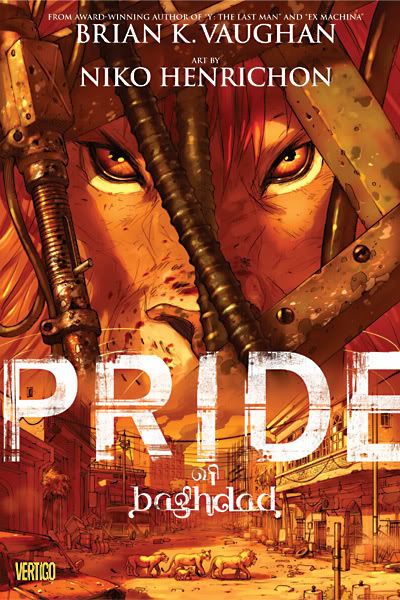Pride of Baghdad arrives in stores today so I thought I'd republish an early review of the book I wrote.
This book could very well be known as the best thing Brian K. Vaughan has written. That’s not to say the book is flawless, though. It follows four lions that live in the Baghdad Zoo who are freed when American forces bomb the place. There’s the male lion Zill, the cub Ali, his mother Noor and the older female lion Safa, who is blind in one eye. Vaughan does a great job of infusing characterization into all their dialogue even if it takes some time adjusting to seeing incredibly realistically rendered animals, drawn by Niko Henrichon, speaking very mannered dialogue. Thankfully these characters avoid a trope of Vaughan’s writing that bothered me in Ex Machina. There characters' dialogue often became simple exchanges of trivia Vaughan looked up. Animals don’t have encyclopedias so they aren’t lecturing one another about what New York City Hall looked like in 1807. With Pride Vaughan concentrates on one of his strengths, crafting dynamic relationships between a group of characters (think of the kids in Runaways). This intersection of realistic animal characters digesting realistic human behavior did provide for one scene that I felt was problematic. In a flashback one of the lions remembers getting raped back when she lived in the wild. I understand it explains her reluctance to join the free world but I can't wrap my mind around the idea of rape in the animal kingdom, since scientists still aren’t sure how far the idea of consent and non-consent can apply to wild animals. I didn’t let it bother me for long because I understand that the larger goal in this book for Vaughan is using animals to try and to reconcile “enlightened” human ideals with primal ones.
The driving theme of the book is established early on, that of a life of freedom, which includes risk, versus a life in safe captivity. The animals in the zoo are forced into freedom due to American aggression in their homeland. It could be argued that due to circumstances they are still not free, indeed that is an idea touched on in the story. The progression of the story is built on a sequence of episodes commenting on how human society manifests itself. In some of them, such as the introduction to a wise old turtle, the lions just listen in curious bewilderment. The characterization of the lions is the saving grace for many scenes where the allusions and metaphors seem a bit wonky. With four lead characters providing different views on freedom of choice Vaughan contemplates interesting ideas here and crafts an enjoyable tale. Soon though I started feeling a bit frustrated when I realized a strong point wasn't being made. That's not necessarily a problem, perhaps it is better when an artist simply raises questions instead of supplying answers, but Vaughan employs some heavy-handed symbolism in the book as well. The notion of cutting off a nose to save a face is used literally here, to say nothing of a moment near the end where the American flag appears. The tour of humanity’s follies Vaughan gives his lions is through-provoking and entertaining but there's a troublesome inclination to be both heavy-handed and vague.
Henrichson’s artwork is a high point for the book. His illustration of many different types of animals is strong and confident. An almost unbelievable story looks believable through Henrichson's skill of anatomy and movement. There are many scenes in the book where the lions come upon cities ruined by war. Henrichson gives these scenes big wide panels that create a valuable sense of place. Vaughan’s writing and concept for this book will bring in a lot of interest but I hope the real find for readers will be Henrichson’s artwork. Vaughan has some interesting things to say but it is Henrichson who provides the real gravity and sense of importance to this book.

No comments:
Post a Comment